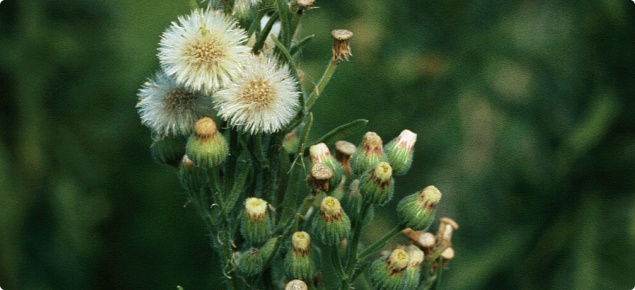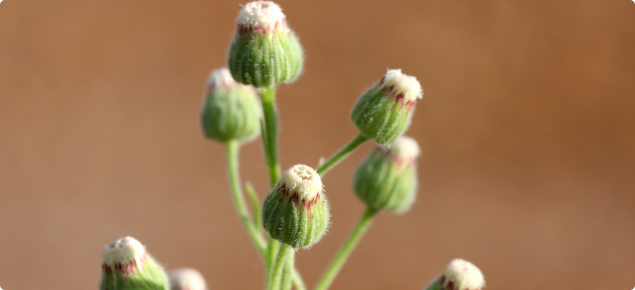Identification and attributes
There are two main species of fleabane in Australia, namely Conyza bonariensis (flaxleaf fleabane) and C. albida (tall fleabane). C. canadensis (Canadian fleabane) also occurs but is less prevalent.
Distinguishing features
Both of the common fleabane species are upright tap-rooted annuals in the daisy family. On maturity they both produce compact seed heads with a parachute of fine hairs. The light fluffy seeds are readily dispersed by wind. Flaxleaf fleabane is a grey hairy plant, growing to 1 metre (m) tall and the inflorescence (cluster of seed heads) resembles a candelabra. Mature plants of flaxleaf fleabane produce an average of 110 000 seeds each. Tall fleabane has lighter green leaves and grows to 2m.
| Characteristic | Flaxleaf fleabane (Conyza bonariensis) | Tall fleabane (C. sumatrensis) |
|---|---|---|
| Mature plant height | 1m | 2m |
| Stem branching | Branches below each pyramid of inflorescences | Branches only at the inflorescence |
| Inflorescence shape | Candelabra | Pyramid |
| Flower colour | White to pink | Greenish white |
| Leaf colour | Grey-green | Green |
Biology
Fleabane in WA can germinate throughout the year, but is most common in spring. Emergence is staggered, so it is difficult to control all cohorts of seedlings.
Flaxleaf fleabane flowers/produces seed throughout the year and the pappus on the seed enables it to be dispersed long distances by wind. Fleabane is a prolific seed producer, each plant producing up to 110 000 seeds. Of these seeds, up to 80% can be viable. The seeds do not possess dormancy so they can germinate whenever temperature and moisture requirements are met. Prevention of seed-set is vital for control.
Fleabane seeds can only emerge from on or near the soil surface (under zero or reduced tillage systems). The depth of burial affects seed survival of fleabane. When sown on the surface, 5% of the seed remains viable after 12 months. After burial at 50 millimetres (mm) and 100mm for 12 months, 10% and 15% of buried seeds maintain their viability.
Why is it a weed?
Fleabane is a major weed of fallows and competes for the vital resource of soil water in both crop and fallow phases. In WA, fleabane often germinates in spring and early summer prior to harvest. Once the crop is removed, the fleabane has no competition for light or moisture and can grow rapidly, especially with further summer rain. By the time there is a window for control, the fleabane are often large with an extensive root system and a reduced leaf area. This makes the plants tolerant to most herbicides. Large infestations of summer weeds have been implicated in reductions in available soil moisture for the following crop resulting in yield losses.
Herbicide resistance
Fleabane is very difficult to control with herbicides. Inconsistent control is often obtained with herbicide treatments, especially once plants exceed a diameter of 30mm. Where fleabane becomes a problem in fallows, weed control costs can increase by up to 80% due to the difficult nature of control.
There is confirmed resistance of flaxleaf fleabane to glyphosate in the eastern states of Australia. One biotype in New South Wales showed 32 times higher glyphosate resistance compared to a susceptible biotype. Overseas research has documented glyphosate resistant fleabane as well as resistance to Group B (chlorsulfuron), Group C (atrazine and simazine), and Group L (diquat and paraquat).
Tactics for integrated weed management
| Management tactic | Most likely % control (range) | Comments on use |
|---|---|---|
| Improving crop competition | 50 (30-70) | Avoid wide row cropping in weedy paddocks. |
| Pre-emergent herbicides | 90 (85-99) | Long-term control applied pre-, at or post-planting. Use high recommended rates for better control. |
| Selective post-emergent herbicides | 90 (85-99) | Target young weeds; timing is critical. Rely on mixtures at sufficiently high rates, especially in fallow. |
| Spot spraying, chipping, hand roguing, wiper technologies | 90 (80-99) | Very effective to reduce potential populations where there are small numbers of survivors. |
Control
Fleabane can most effectively be controlled when they are emerging, mainly in early spring while they are still small. Small fleabane plants are relatively easy to kill and a late post-emergent application of some Group I (phenoxy) herbicides during spring can control them in cereals.
- The new Health (Pesticides) Regulations 2011 now allows for ‘The Use of a Pesticide for an Unspecified Pest on a Registered Crop’. This is important where the herbicide is registered for the crop but the weed in question is not on the label. A range of Group I herbicides are registered in WA for a range of weeds (for example, wild radish) for use in cereals.
- Flaxleaf fleabane is not on the Group I herbicide label but work done by Andrew Storrie and Tony Cook in NSW suggest that phenoxy herbicides are very effective on small fleabane.
- Post-emergent application of Group B herbicides (chlorsulfuron) could also be effective on the new emergence of flaxleaf fleabane.
- Fleabane germinates in late winter/early spring in WA around the time that a late application of these Group I herbicides is registered and can be applied in cereals.
- Monitoring winter crops following spring rain will enable effective control of small fleabane before harvest.
Mature fleabane can be difficult and expensive to kill, especially in mid to late summer.
- Trials conducted by Department of Primary Industries and Regional Development (DPIRD) researcher Sally Peltzer in 2009 and by Mohammad Amjad in the summer of 2014/2015 indicated that the best control of large fleabane in stubble used a ‘double-knock’ approach with a range of primary herbicides followed by paraquat 7-10 days later.
- The most effective treatment was an application of glyphosate (540 grams per litre (g/L)) at 2 litres per hectare (L/ha) or glyphosate (540g/L) at 2L/ha + 2,4-D amine (625g/L) at 2L/ ha with a follow up spray of paraquat at 2L/ha seven days after the initial treatment
- Glyphosate (540g/L) at 2L/ha or glyphosate (540g/L) at 2L/ha plus 2,4-D amine (625g/L) at 2L/ha applied as a single dose and without the follow spray of paraquat provided good but incomplete control.
Fleabane is also difficult to control in late spring but can be achieved if the plants are less than 5cm.
- Trials conducted in 2009 indicated that diquat (200g/L) at 3L/ha can be used as a salvage spray in-crop in late spring provided the fleabane is small (less than 5cm) The larger plants tended to grow out of it.
- A mixture of 2,4-D (625g/L) at 1.7L/ha plus metsulfuron (600 grams per kilogram (g/Kg)) 5g/ha provided adequate control of fleabane in the late vegetative stage. This treatment was used after the crop was harvested for hay.



